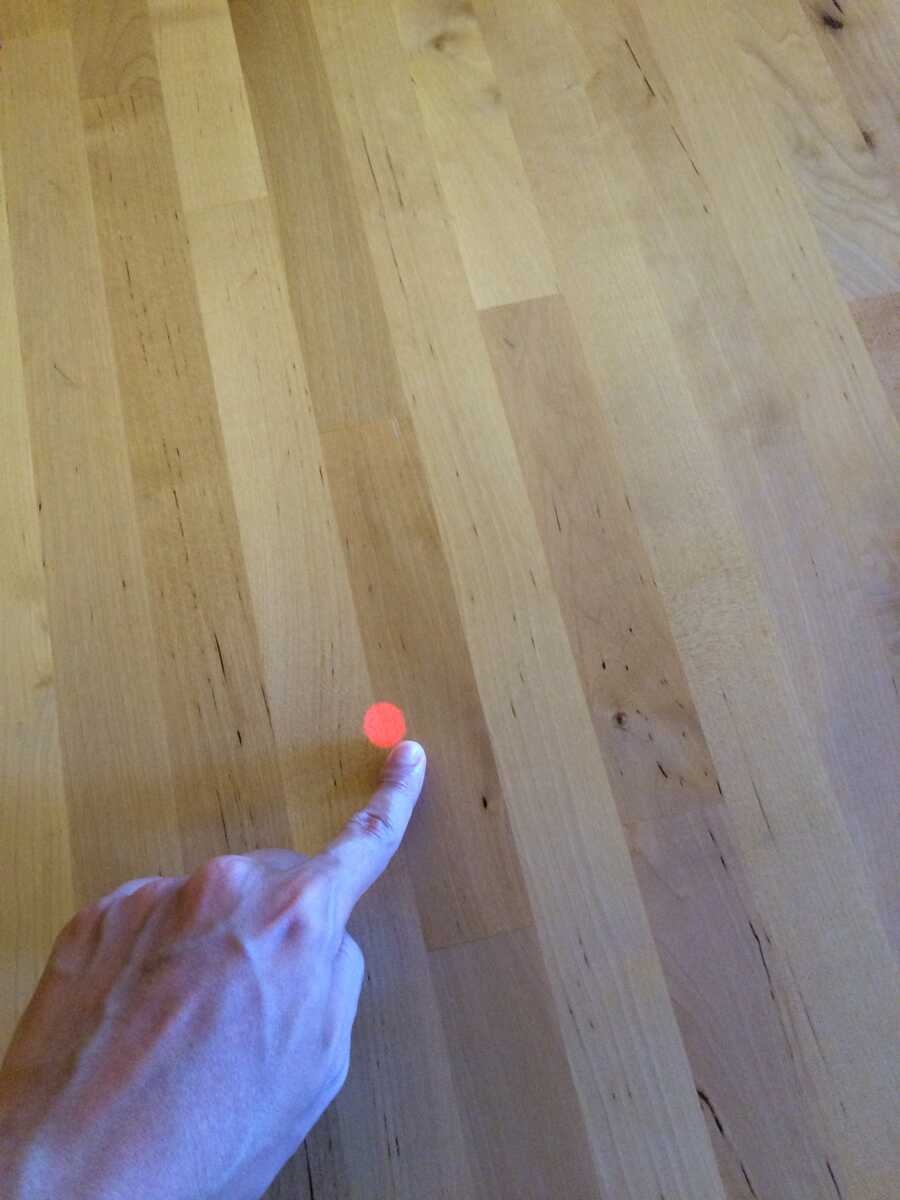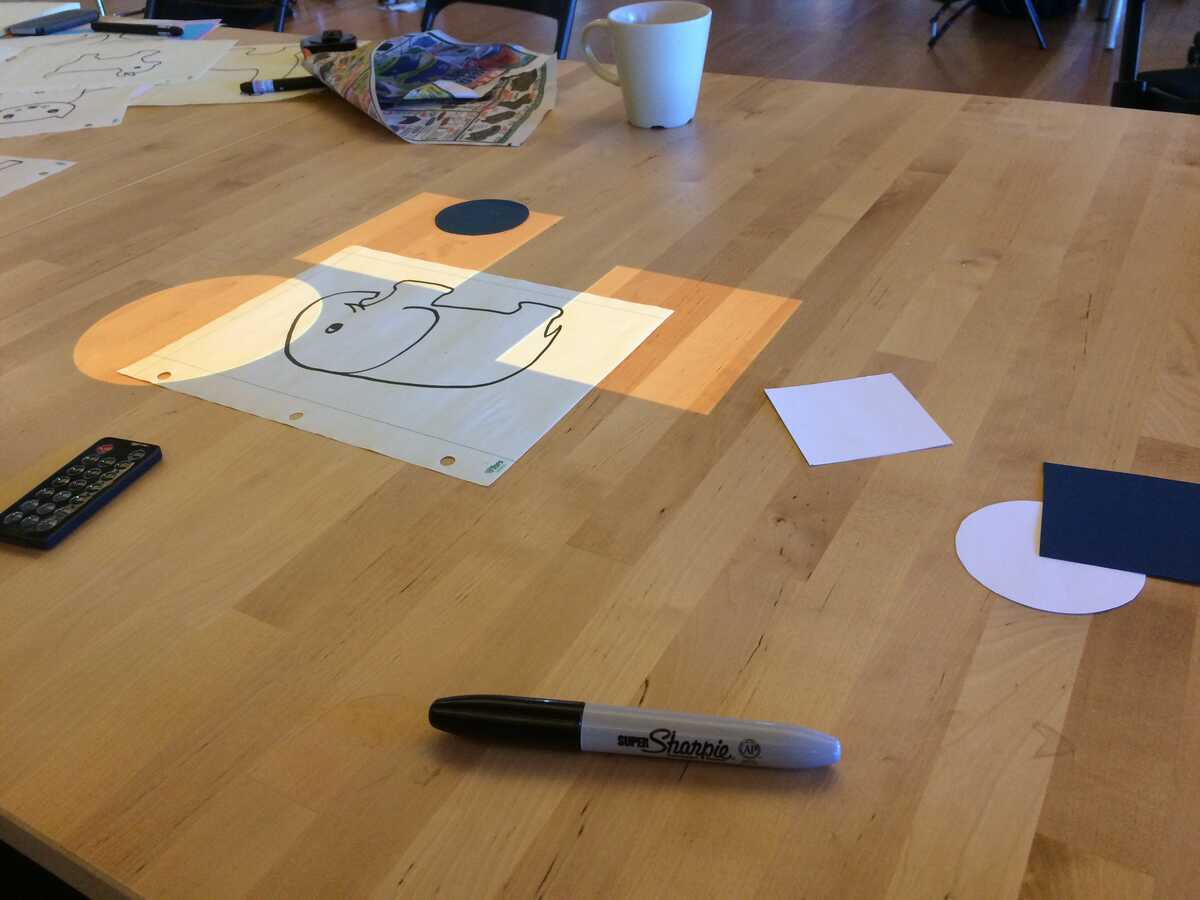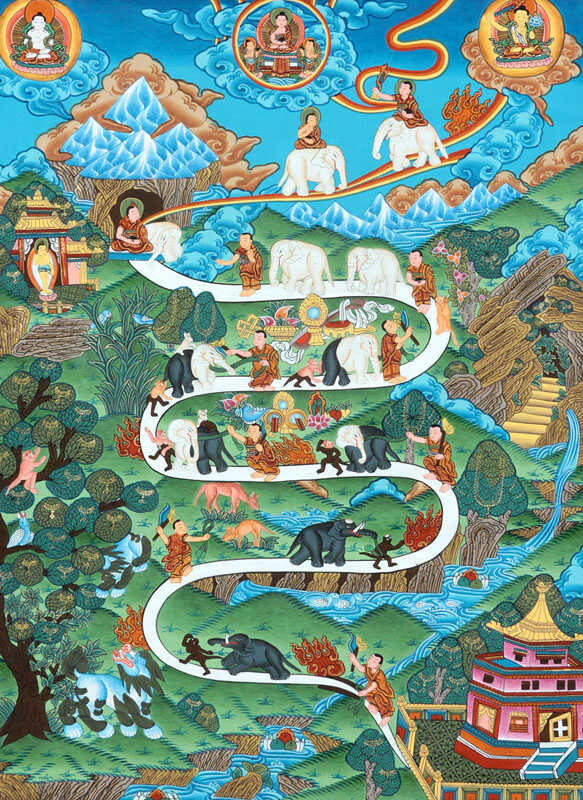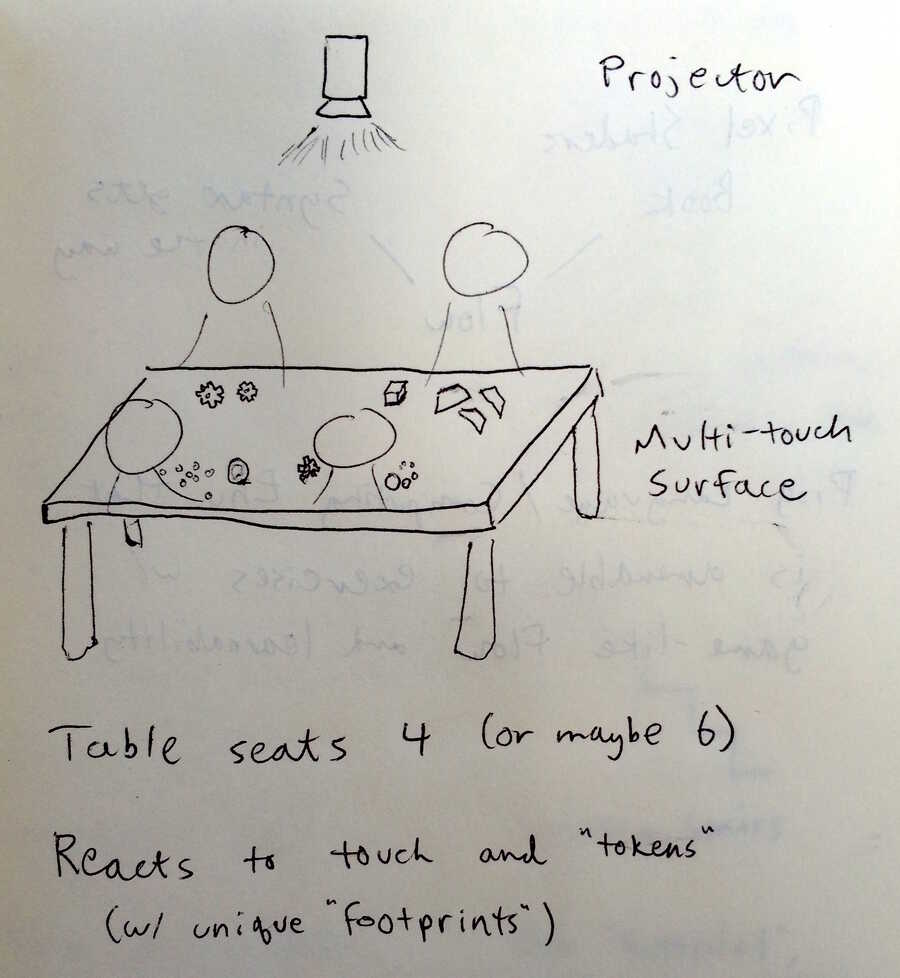In-progress documentation. Kinect for touch tracking works, barely. Hopefully the Kinect v2 (on its way), which has finer depth resolution, will do a touch interaction that is smoother.
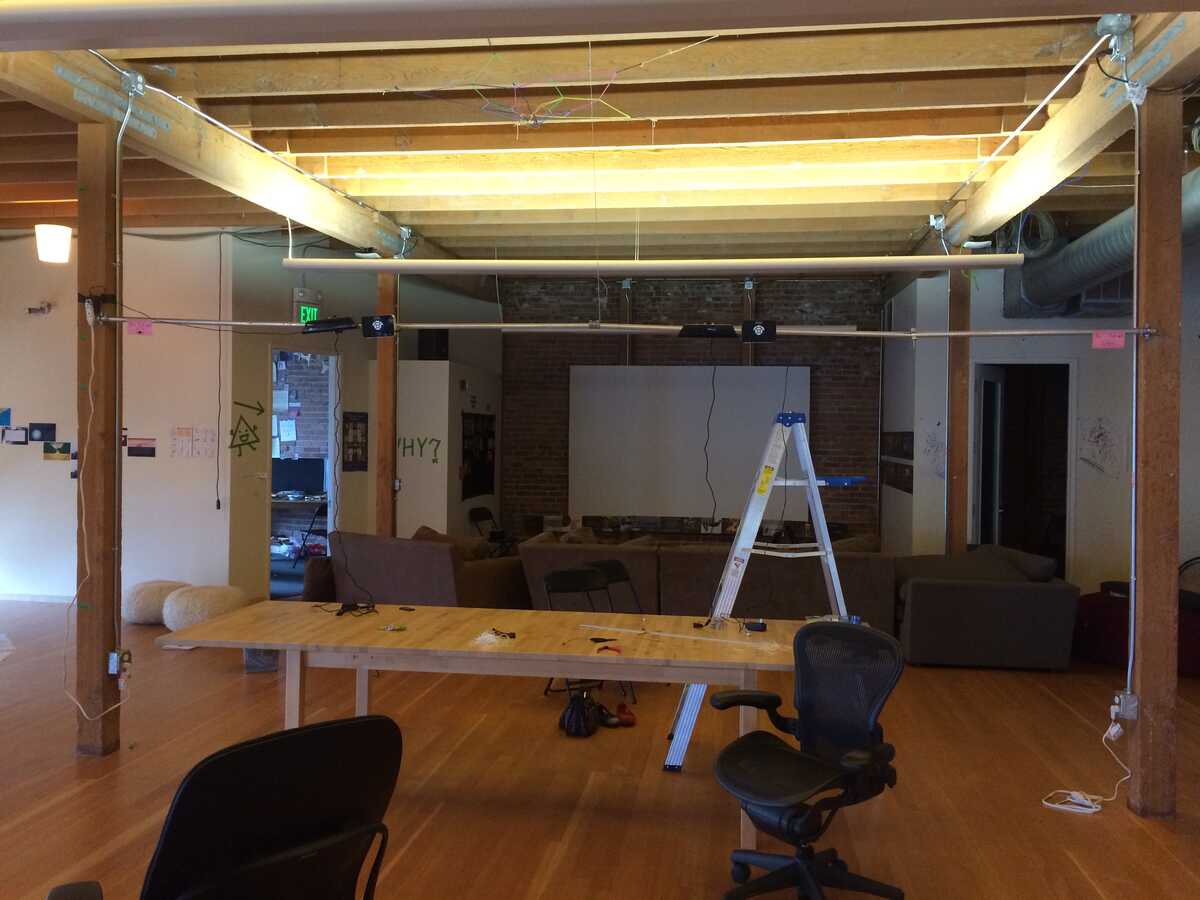
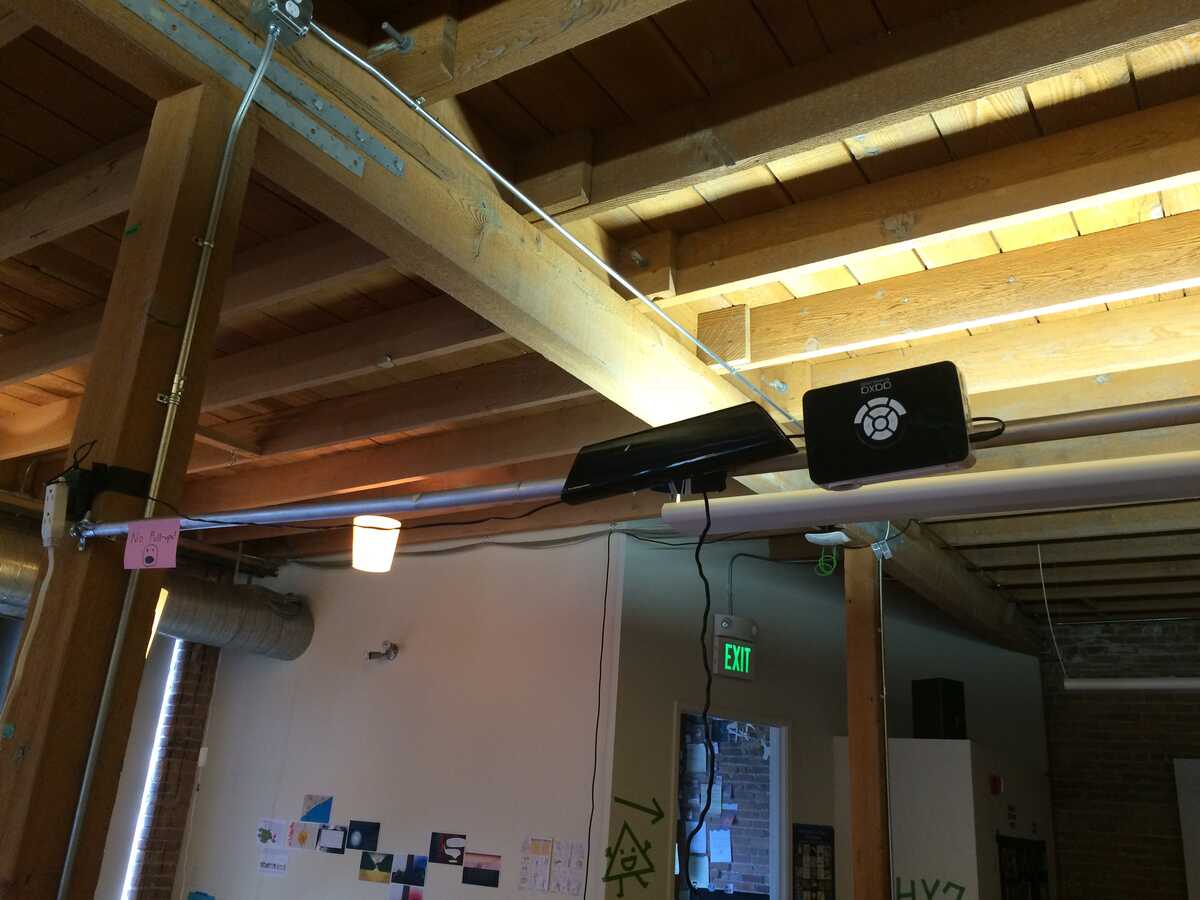
On the other hand, I'm pleased with the "mounting bar" that Nagle and I put up. We used 1"x8' aluminum tubing from Lowe's (had to go to two locations to get two pieces). Then using various pieces intended for electrical conduit to mount.


On Mon, Jun 8, 2015 at 12:30 PM, Michael Nagle wrote:
On Fri, Jun 5, 2015 at 5:46 PM, Toby Schachman wrote:Following a thread that was started with the "Noun Project wall" and Nagle's observations about how the chess learning community operates, I've been really interested in what it would mean to be able to make software, or make any computational stuff, together.I'll elaborate on this idea of togetherness, but I'm reminded of the passage in Mindstorms about samba schools,During the year each samba school chooses its theme for the next carnival, the stars are selected, the lyrics are written and rewritten, the dance is choreographed and practiced. Members of the school range in age from children to grandparents and in ability from novice to professional. But they dance together and as they dance everyone is learning and teaching as well as dancing. Even the stars are there to learn their difficult parts.Every American disco is a place for learning as well as for dancing. But the samba schools are very different. There is a greater social cohesion, a sense of belonging to a group, and a sense of common purpose. Much of the teaching, although it takes place in a natural environment, is deliberate. For example, an expert dancer gathers a group of children around. For five or for twenty minutes a specific learning group comes into existence. Its learning is deliberate and focused. Then it dissolves into the crowd.Papert goes on the describe the similarities and differences between LOGO and samba schools. But he doesn't point out one of the big differences, which is that in samba, the practice is extremely visible--visible to everyone in the space. If one of those spontaneous learning moments happens you can see that it's happening and join in.I think building on this, there's something really phenomenal and perhaps unique about group dynamics, where maybe visibility is the jumping off point.It seems to me like humans entrain to one another, and there are aspects of mental state that have a kind of collective element. We see each other, but I think we also feel each other on a surprisingly deep level.One thing I love about the Mechanics Institute -- which hosts the chess club I play at -- is I feel like the group flow state is just utterly palpable. You walk in and 80 - 100 people are concentrating their skulls out. I don't know how to explain it beyond 'you can feel it.' But it feels like a collective flow state that you can dive into. One thing that interests me about this: I've studied Tibetan Buddhism for the past few years, with a teacher who was a professor of psych at Harvard medical. So he'd make all of these connections between what he felt like the Tibetan practices were describing and western psychology. And he made the came that in a kind of standard sequence of concentration practices -- nine successive meditations that take you into deep and deeper states of focus [1] -- that he felt like the seventh in these matched what Csikszentmihayi called a flow state. After I found myself playing chess again -- and finding it similar at least to this concentration practice, if not a certified 'flow state' -- I found myself wondering if this was a western analog to a tibetan buddhist practice. A game -- a set of objects and rules -- designed, perhaps unconsciously, to set up the conditions for a deep concentration state if one went down the rabbit hole long enough. (As opposed to a series of instructions about working with your attention and awareness directly, as in meditation.)The idea that these different physiological states have group analogs interests me a lot, in terms of understanding the potential of learning containers and communities. I can't remember if Csikszentmihayi talks about group phenomena in _Flow_? I recall it as about being about the individual phenomenon but I really don't remember the book.[1] I've always thought the visual representation used for this concentration series, "the elephant path," was really interesting. The gist is it shows an elephant (cognition) turning white (getting tamed) as it walks up this path. It uses all kinds of visual iconography to indicate what the path is like -- flames when you need to be more intense, a rabbit sitting on the elephant for when you tend to get tired on the path, etc. etc. I was surprised to have this visual unpacked for me and find that a lot of the symbolism has a concrete pointer to remind you what it's like to navigate this concentration series and what each particular step is like.And even when there isn't "deliberate and focused" learning, you pick up quite a lot of the dance just by watching other dancers. Sometimes you look for specific details (how does she do that one move) and sometimes you just pick up on overall "rhythms" (getting inspired by a dancer's quality of movement). At least this is my experience in e.g. capoeira class, breakdancing club, etc.I think another very deep question here is what the role of the teacher or master becomes when we work forward from a learning community and not backwards from a classroom.There's this idea, which I think is hard to name but again palpable, where learning can just transmit from person to person, perhaps along an expertise gradient, and it feels incredibly 'natural.' It seems to me that natural learning happens in a way that is very emotionally consonant for the learner -- they rarely have the spectre of negative identity surface as they feel like they are fully engaged be it in observation, mimicry, or explicit or implicit inquiry (asking for help, wondering to one's self, etc.)I realize on writing this that I have a hope that one day we will look at 'teaching' more as the skill of group facilitation, and we will see the classroom / teacher dynamic as just outmoded altogether. I would need to think more about that claim, really think it through, but it's where my instincts lie. That part of what gets me very confused and upset when I talk to many people about learning is that teaching seems to be the relational ramification of our existing pedagogical mode (transmission-based learning on socially pre-determined tracks) and what I deeply wish for in the world is a learning society where the task of those more experienced is to figure out how to extend and facilitate the invitation to deep learning and play. Making learning more wonderful, not more palatable.This has reverberated through my mind in a few different ways. One is in a conversation last week -- I was reminded of this blog post I wrote about Camp Kaleidoscope. I was beginning to become conscious of my role at Kaleidoscope as a kind of conductor. There were direct facilitation or teaching skills I had -- thoughts about how to clearly communicate an activity, about how to handle conflict between children, about what boundaries and rules to be firm and what to let slip -- but I began to feel that increasingly, my role was to be aware and mindful of the space and the children, and try to just make small adjustments here and there to prevent large-scale conflict from erupting and to make sure that enough learning paths were open that every individual had a deep path to be moving down.the focus in this post was on the audible aspects of healthy creativity. I think I was walking around with a parent, and doing the arc that I did a lot -- how do we deconstruct the schooling model in your mind and let this alternative, wild-looking model in? And so I was walking around and pointing out what I heard. That often classrooms have a kind of chilled silence that we get used to, but would find alarming if we walked into say a group of artists having a work day together. And often classrooms regulate around that silence as a kind of equilibrium, but it's rare that the depth of engagement they have truly merits it. (I think often it's a reification of a culture of control or fear in a classroom -- where you have to ask to go to the bathroom or just for basic rights over your human body.)But I think it also casts the facilitator in an interesting light -- learning to sense these group dynamics, and tweak and tune them, without being overly assertive and letting the wild individual processes lead where they lead. A container for divergence.I think this skill -- which seems to be written about in psychotherapy to some extent, about leading groups, or facilitating communities (M. Scott Peck's 'A Different Drum' echoes a little bit here for me) -- is a really interesting one.It came to mind in another angle for me recently. The facilitator of the religious ceremonies I've been going to (with the Santo Daime church. An NYT article about them here. ) recently described herself as being extremely good at micromanaging. So she can track 20 people's experiences while this whole group work is going on. And it reminded me of my own experiences facilitating Camp Kaleidoscope -- trying to simultaneously hold a picture of every individual as well as a collective whole, and to understand when an individual intervention is needed, and when it makes sense to simply operate 'on the whole.'The Daime ceremonies also contribute to my feeling that there is an immensity of depth in the group container and the group physiological experience, that perhaps we don't have good language for at the moment, or find it hard to ordinarily be aware of.So, I was trying to come up with a setup where this kind of computing together could be tried out. Here's my idea:I drew a similar picture in my notebook recently.In this I'm evolving my Vivarium-is ideas, and trying to look at a physical terrain + digitally projected simulation of life setup. The idea is there's an RMO box above the setup for camera + projection and the kids eventually have some way (tablets?) of programming digital life and adding them in to the scenario.This sketch is based off my friend Danna's article about millipedes that glow. They glow more with more elevation. Elevation correlates to more predators, and the glowing also correlates to the amount of cyanide the millipedes contain -- so it's a dynamic warning signal. A paper just came out looking at how this trait could have evolved, since it is only useful on a whole population scale.But my sketch gets me wondering -- in what ways is the augmented setup domain specific? And in what ways can we understand it more generally? I find I'm thinking in physical substrates that are somehow enhanced digitally. And maybe those substrates change for the topic. You want a physical model of a mountain for a biological system in a mountain. Maybe you want Glen's video blocks for video editing, and maybe you're doing some kind of image detection + projection thing on them so that the video as newly sequenced is playing somewhere on the table depending on how the blocks are laid out, with some kind of scrubbing gesture available. Etc. It seems interesting to me to think about how the physical substrate changes as the activity changes.
